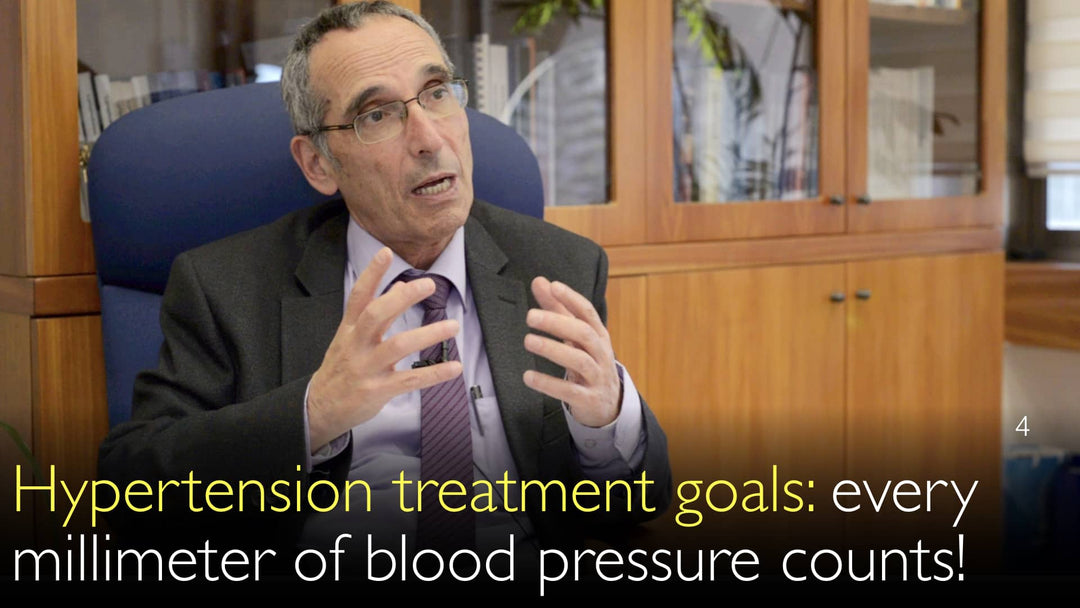Leading expert in hypertension and cardiovascular risk, Dr. Ehud Grossman, MD, explains the critical importance of blood pressure control. He details how every millimeter of mercury reduction in blood pressure significantly lowers heart attack and stroke risk. Dr. Ehud Grossman, MD, discusses the complex balance between treatment benefits and medication side effects in personalized hypertension management. He emphasizes that treatment guidelines provide direction, but individual patient decisions are paramount.
Optimizing Blood Pressure Goals to Prevent Heart Attack and Stroke
Jump To Section
- Hypertension and Diabetes Cardiovascular Risk
- Blood Pressure Reduction Benefits
- Personalized Hypertension Treatment
- Guidelines vs Individual Decisions
- Patient Role in Treatment Decisions
- Full Transcript
Hypertension and Diabetes Cardiovascular Risk
Dr. Ehud Grossman, MD, highlights a critical connection between hypertension and diabetes. Patients with both conditions face cardiovascular risks equivalent to those who have already suffered a heart attack. This elevated risk profile means diabetic patients often require aggressive preventive treatments. These treatments include aspirin and cholesterol-lowering medications, similar to secondary prevention strategies.
Blood Pressure Reduction Benefits
Dr. Ehud Grossman, MD, emphasizes that every millimeter of mercury in blood pressure matters. A difference of 20 mmHg in systolic or 10 mmHg in diastolic pressure can double the risk of cardiovascular events. For example, an 80 mmHg difference increases risk tenfold. The benefit of reduction is not linear. The greatest benefit comes from lowering very high blood pressure initially. Moving from 180 to 140 mmHg systolic offers substantial risk reduction. Further lowering from 140 to 130 mmHg provides smaller, incremental benefits.
Personalized Hypertension Treatment
Dr. Ehud Grossman, MD, explains that hypertension management is the essence of personalized medicine. Physicians must balance the benefit of each blood pressure reduction against potential medication side effects. This decision-making process is highly individual. It depends on the patient's starting blood pressure, overall health, and tolerance for medications. The goal is to achieve the best outcome with the least burden of side effects.
Guidelines vs Individual Decisions
Hypertension treatment guidelines provide a essential framework for care. However, Dr. Grossman clarifies that they are not rigid commands. They offer a direction, but the journey is unique for each patient. The physician's clinical judgment is crucial in applying these guidelines. Dr. Anton Titov, MD facilitates this discussion, exploring the nuances of clinical application beyond the published recommendations.
Patient Role in Treatment Decisions
Dr. Ehud Grossman, MD, strongly advocates for shared decision-making in hypertension management. The patient is a central partner in their care. Physicians must clearly explain the benefits of achieving lower blood pressure goals. They must also discuss the potential for medication side effects openly. Ultimately, the patient decides on their treatment path after understanding the risks and rewards. This collaborative approach ensures treatment plans are both effective and sustainable.
Full Transcript
Dr. Ehud Grossman, MD: It's a very interesting statistic that in people who have diabetes, having also hypertension means the same cardiovascular risk factors as in people who already had a myocardial infarction.
Right! That's one of the old studies that showed that the risk of heart attack and stroke in patients with diabetes is much higher than the general population. Once you have diabetes, in some sense it is "secondary prevention," which means that it's like someone who already has had myocardial infarction because the risk is so high that it is the same as the risk of someone who had myocardial infarction.
That's why not all guidelines say the same, but in some guidelines diabetic patients require treatment with aspirin and cholesterol-lowering medications, like those who had myocardial infarction in the past.
It's also very interesting that when we talk about blood pressure, we talk about differences in blood pressure goals of 10 millimeters of mercury. A lot of people say, plus or minus 10 units of blood pressure measurement is actually not that much, but it turns out it means a lot!
It's very important, of course. When you take the individual person, it's not the same as if you take a million people and you see what is the difference in the events when the blood pressure is lowered by 10 millimeters of mercury.
Each 20 millimeters of mercury in the systolic blood pressure and 10 millimeters of mercury in the diastolic blood pressure doubled the risk of heart attack and stroke. If you see a patient with 115 systolic blood pressure, then someone with 195—80 mm Hg blood pressure difference increases the risk by tenfold, which is huge.
So it's very clear that blood pressure difference of 10 millimeters of mercury counts. For the person himself it may be different, but when you take the average, you take the epidemiology of many people, you understand that each millimeter of mercury in blood pressure counts.
So there is no such thing as non-meaningful difference in blood pressure. Of course, people should really try to achieve the blood pressure goals in treatment that are assigned to their category of risk.
The point is that the trend is not the same. When you go down from 180 to 160, the 20 millimeters of mercury difference gives you a very significant reduction in events, but when you go from 140 to 120, now you get less benefit.
So the difference about 20 millimeters of mercury depends on from what you start to where you go. And of course that's why we say, OK, if you go to 140, most of the benefit you've already achieved by reduction from 180 to 140 systolic blood pressure.
Now, the question is what is the additional benefit from lowering from 140 to 130? Let's say that there is an additional benefit, but it's low, and then you say how much you have to pay for it—not in money—but in side effects of medications?
And then you have to wait and see if it's worthwhile to try and lower the blood pressure 10 millimeters more and expose the patients to side effects, etc. So this is personalized medicine—that's the difference between doing a large study on million people or a few hundreds thousands of people.
But when you treat a specific patient, you have to balance the benefits versus the disadvantages. And that's why hypertension treatment guidelines are so complicated. There is a lot of room for personalized decisions that physician might take.
No question! The guidelines give you just a direction, but whether you want to go through this direction to reach the goal—it depends on the physician. It also depends on the patient himself—you have to explain to the patient what is the situation, what may be the side effects, what is the benefit, and then patient decides on treatment.







